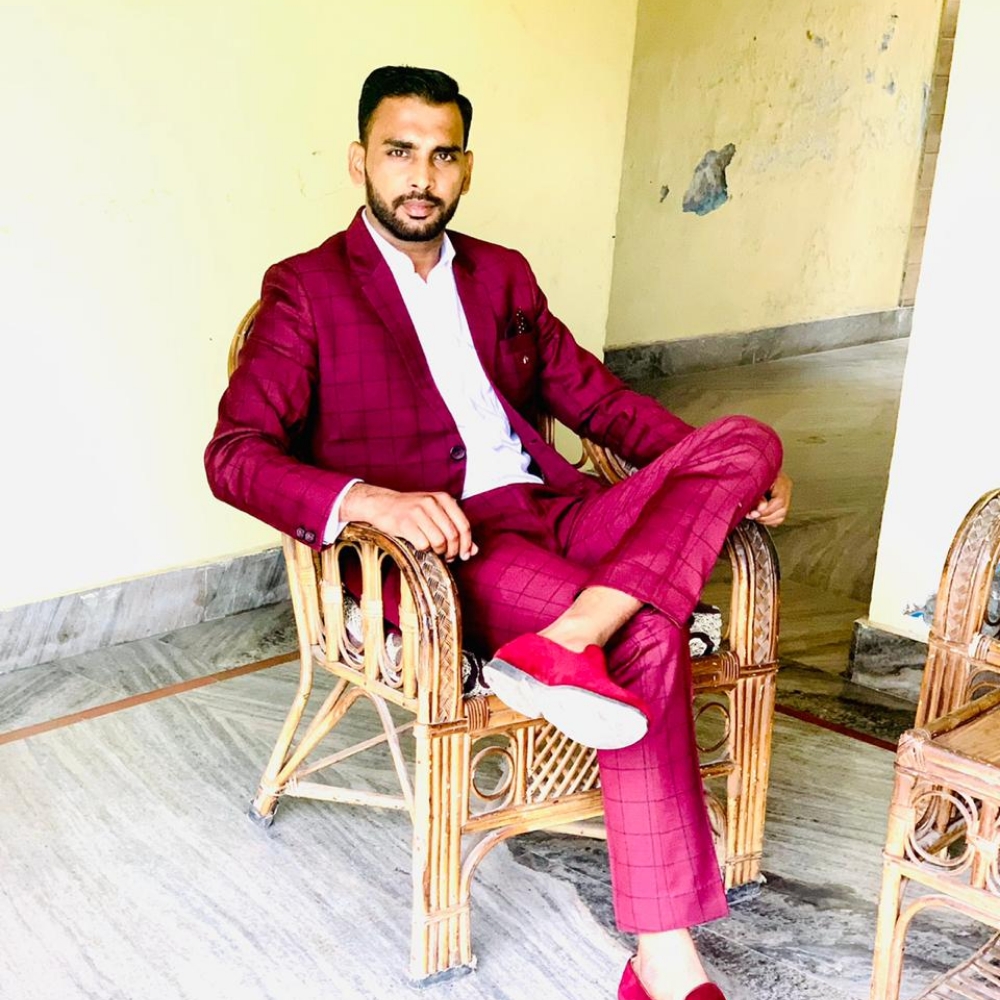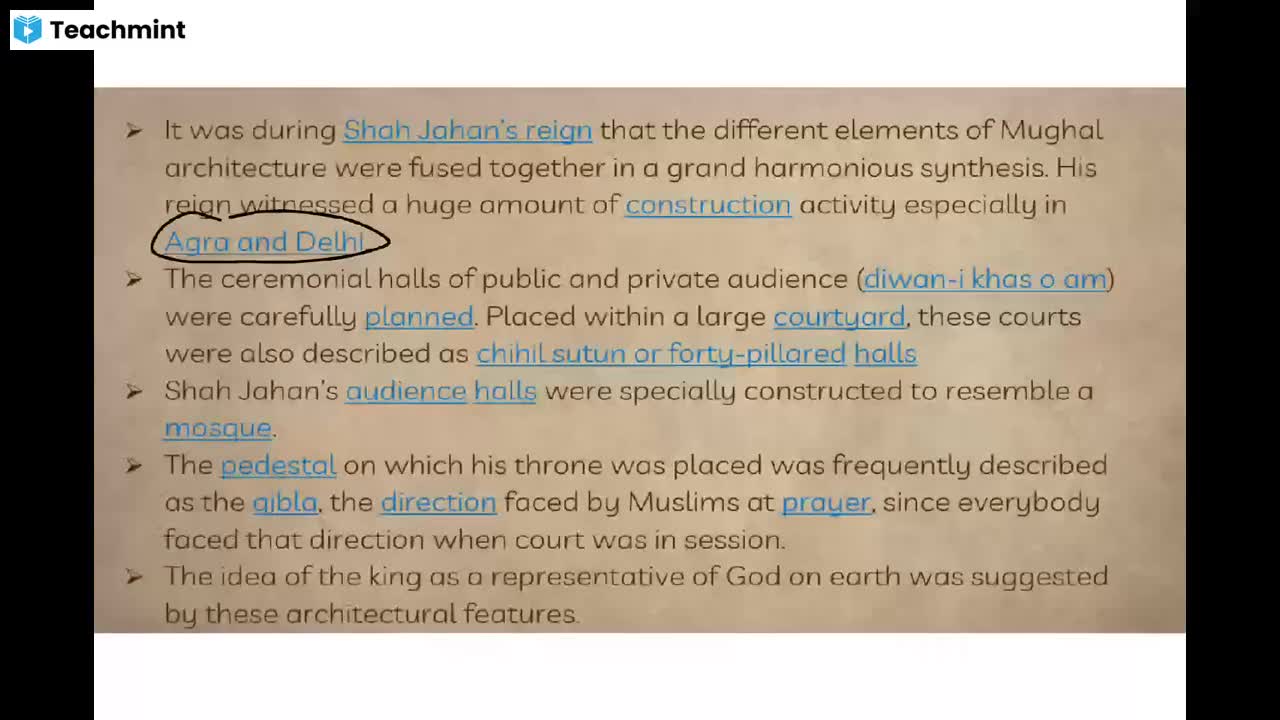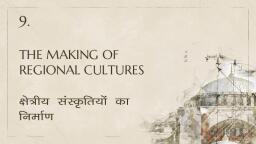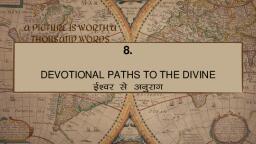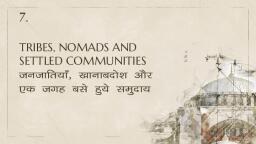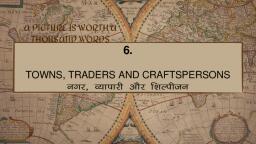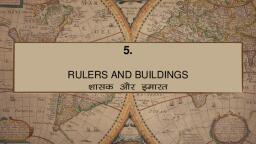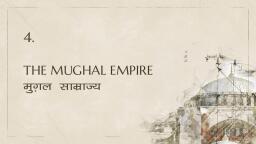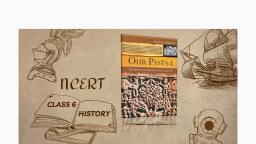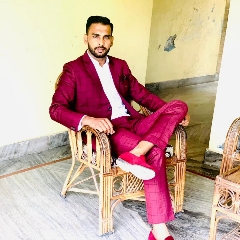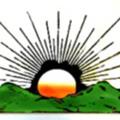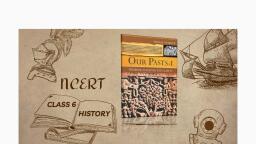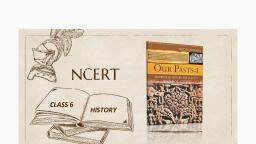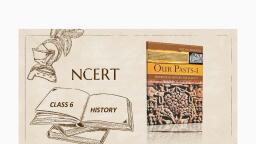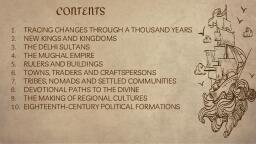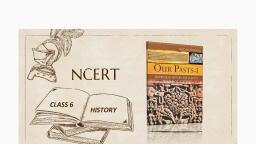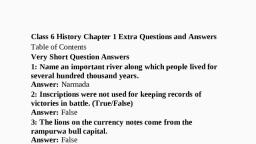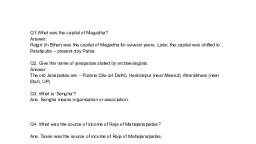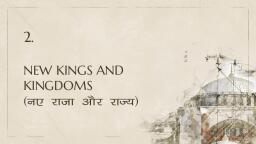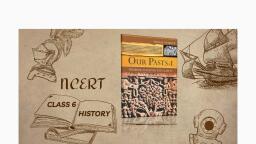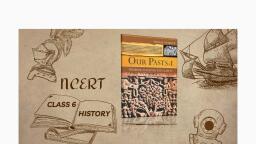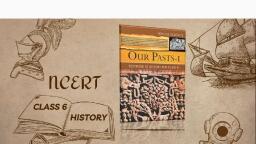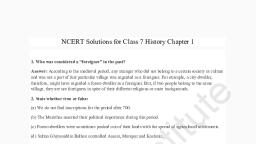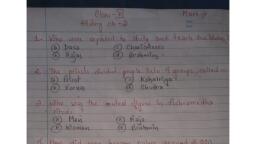Page 2 :
A PICTURE IS WORTH A, THOUSAND WORDS, , 5., KINGDOMS, KINGS AND, AN EARLY REPUBLIC
Page 4 :
HOW SOME MEN BECAME RULERS ?, Rajas were probably chosen by the jana, the people., But, around 3000 years ago, Some men became as, rajas by performing very big sacrifices., E.G. THE ASHVAMEDHA or HORSE SACRIFICE ., A horse was let loose to wander freely and it was guarded by the raja’s men., If the horse wandered into the kingdoms of other rajas and they stopped it, they, had to fight., If they allowed the horse to pass, it meant that they accepted that the raja who, wanted to perform the sacrifice was stronger than them. These rajas were then, invited to the sacrifice, which was performed by specially trained priests, who, were rewarded with gifts.
Page 5 :
The raja was a central figure in these rituals. He often had a special seat, a throne, or a tiger skin., His charioteer, who was his companion in the battle field and witnessed his, exploits, chanted tales of his glory., His relatives, especially his wives and sons, had to perform a variety of minor, rituals. The other rajas were simply spectators who had to sit and watch the, performance of the sacrifice., Priests performed the rituals including the sprinkling of sacred water on the king., The ordinary people, the vish or vaishya, also brought gifts., However, some people, such as those who were regarded as shudras by the, priests, were excluded from many rituals.
Page 6 :
VARNAS, Many books that were composed in north India, especially in the areas drained by, the Ganga and the Yamuna, during this period (often called later Vedic, because, they were composed after the Rigveda ). These include the Samaveda, Yajurveda, and Atharvaveda, as well as other books., These were composed by priests,, and described :, how rituals were to be performed., contained rules about society.
Page 7 :
There were several different groups in society at this time —, , priests and warriors,, farmers, herders,, traders, crafts persons, labourers,, fishing folk, and forest people., Some priests and warriors were rich, as were some farmers and traders., , Others, including many herders, crafts persons, labourers, fishing folk, and hunters and gatherers, were poor., The priests divided people into four groups, called VARNAS.
Page 8 :
VARNAS, .., According to them, each varna had a different set of functions :, 1. Brahmins were expected to study (and teach) the Vedas, perform sacrifices and, receive gifts., 2. Rulers, also known as kshatriyas. They were expected to fight battles and protect, people., 3. Vish or the vaishyas ,were expected to be farmers, herders, and traders., (Both the kshatriyas and the vaishyas, could perform sacrifices), 4. Shudras, who had to serve the other, three groups and could not perform any, rituals.
Page 9 :
MANY PEOPLE DID NOT ACCEPT THE SYSTEM OF VARNA LAID DOWN BY THE, BRAHMINS : Some kings thought they were superior to the priests., Birth could not be a basis for deciding which varna people belonged to., There should be no differences amongst people based on occupation., Everybody should be able to perform rituals., Condemned the practice of untouchability., Also, there were many areas in the subcontinent, such as the north-east, where social, and economic differences were not very sharp, and where the influence of the priests, was limited
Page 10 :
JANAPADAS, Literally means the land where the jana set its, foot, and settled down, E.G. Purana Qila in Delhi,, Hastinapura near Meerut,U.P and, Atranjikhera, near Etah,U.P, people lived in huts., kept cattle as well as other animals., They also grew a variety of crops —, rice, wheat, barley, pulses, sugarcane, sesame, and mustard
Page 11 :
They made earthen pots., Some of these were grey in colour, others, were red., One special type of pottery found at these, sites is known as Painted Grey Ware ., These are extremely fine to touch, with a, nice, smooth surface., Perhaps these were used on special occasions,, for important people, and to serve special food
Page 12 :
MAHAJANAPADAS, About 2500 years ago, some, janapadas became more important, than others, and were known as, mahajanapadas., Most mahajanapadas had a capital, city, many of these were fortified (huge, walls of wood, brick or stone were built, around them ).
Page 13 :
FORTS WERE PROBABLY BUILT BECAUSE :, People were afraid of attacks from other kings and needed protection., Some rulers wanted to show how rich and powerful they were by building, really large, tall and impressive walls around their cities., Land and the people living inside the fortified area could be controlled more, easily by the king., Building such huge walls required a great deal of planning., Thousands, if not lakhs of bricks or stones had to be prepared., This in turn meant enormous labour, possibly, by thousands of men, women, and children., And resources had to be found for all of this.
Page 14 :
KAUSHAMBI, The fortification wall at Kaushambi., This is a picture of remains of a wall made of, brick, found near present-day Allahabad, (Uttar Pradesh)., A part of it was, probably built, about 2500 years ago.
Page 15 :
ARMY, The new rajas now began maintaining armies., Soldiers were paid regular salaries and maintained by the, king throughout the year., Some payments were probably made using punch marked, coins.
Page 16 :
TAXES : Instead of depending on occasional gifts brought by people, as in the, , case of the raja of the janapadas, they started collecting regular taxes, Taxes on crops were the most important (most people were farmers)., Usually, the tax was fixed at 1/6th of what was produced. This was, known as bhaga or a share., • There were taxes on crafts persons as well. (in the form of labour)., • Herders were also expected to pay taxes in the form of animals and, animal produce., • There were also taxes on goods that were bought and sold, through, trade., • And hunters and gatherers also had to provide forest produce to the raja.
Page 17 :
CHANGES IN AGRICULTURE : Two major changes in agriculture around this time., , The growing use of iron ploughshares., This meant that heavy, clayey soil could be turned over better than, with a wooden ploughshare, so that more grain could be produced., 2. People began transplanting paddy., This meant that instead of scattering seed on the ground, from, which plants would sprout, saplings were grown and then planted, in the fields. This led to increased production, as many more plants, survived. However, it was back breaking work., Generally, slave men and women, (dasas and dasis) and landless, agricultural labourers (kammakaras) had to do this work, 1.
Page 18 :
MAGADHA : Many rivers such as the Ganga and Son, , flowed through Magadha., This was important for, (a) transport,, (b) water supplies, (c) making the land fertile., Parts of Magadha were forested., Elephants, which lived in forest,could be captured and trained for the army., Forests also provided wood for building houses, carts and chariots., Besides, there were iron ore mines in the region that could be tapped to, make strong tools and weapons.
Page 19 :
Magadha had two very powerful rulers,, Bimbisara and Ajatasattu,, , used all possible means to conquer other janapadas., Mahapadma Nanda was another important ruler., , He extended his control up to the north-west part of the subcontinent., Rajagriha (present-day Rajgir) in Bihar was the capital of Magadha for, , several years., Later the capital was shifted to Pataliputra (present-day Patna).
Page 20 :
ALEXANDER : More than 2300 years ago, a ruler named Alexander, who lived in, , Macedonia in Europe, wanted to become a world conqueror., conquer parts of Egypt and West Asia, and came to the Indian, subcontinent, reaching up to the, banks of the Beas. When he wanted to, march further eastwards, his soldiers, refused. They were scared, as they, had heard that the rulers of India had, vast armies of foot soldiers, chariots, and elephant.
Page 21 :
VAJJI, Capital at Vaishali (Bihar), was under a different form of, , government, known as gana or sangha. In a gana or a, sangha there were not one, but many rulers., These rajas performed rituals together. They also met in, assemblies, and decided what had to be done and how,, through discussion and debate, However, women, dasas and, kammakaras could not participate, in these assemblies
Page 22 :
Both the Buddha and Mahavira belonged to ganas or sanghas., , Some of the most vivid descriptions of life in the sanghas can be, found in Buddhist book., “Ajatasattu and the Vajjis ”, , is an account of the Vajjis from the Digha Nikaya, a famous, Buddhist book, which contains some of the speeches of the Buddha., These were written down about 2300 years ago.
Page 23 :
Rajas of powerful kingdoms tried to conquer, , the sanghas., Nevertheless, these lasted for a very long time,, , till about 1500 years ago, when the last of the, ganas or sanghas were conquered by the, Gupta rulers,
Page 24 :
GREECE AND ATHENS, The people of Athens set up a form of government, which was called a, , democracy, which lasted for about 200 years., All free men over the age of 30 were recognised as full citizens., There was an assembly that met at least 40 times a year to decide on, important matters., All citizens could attend these meetings., Appointments for many positions were made through lottery. All those, who wanted to be chosen gave in their names, and then some were, selected through lottery., Citizens were expected to serve in the army and the navy.
Page 25 :
GREECE AND ATHENS, However, women were not considered citizens., Also, many foreigners, who lived and worked in Athens as merchants and crafts, persons did not have rights as citizens., Besides, there were several thousand slaves in Athens, who worked in mines,, fields, households and workshops. They too were not treated as citizens
Page 26 :
TAKEAWAYS, TRUE OR FALSE :Rajas who let the ashvamedha horse pass through their, lands were invited to the sacrifice., The charioteer sprinkled sacred water on the king., Pots to store grain were made out of Painted Grey Ware.
Page 27 :
THANKS !
